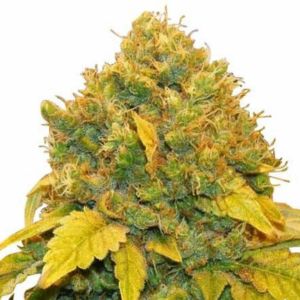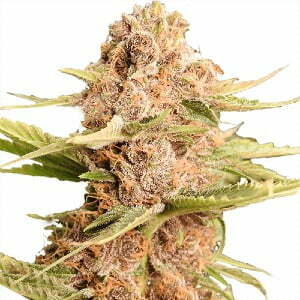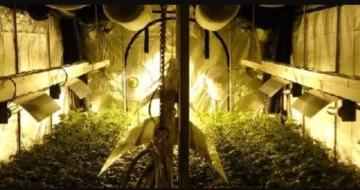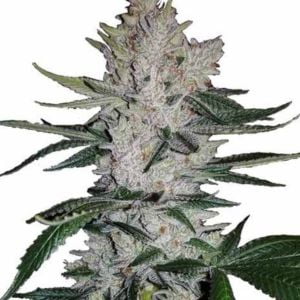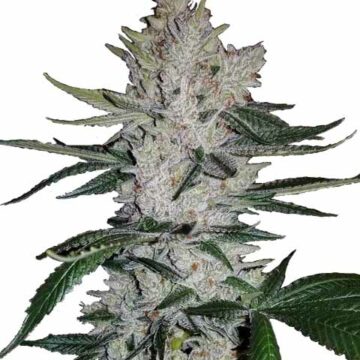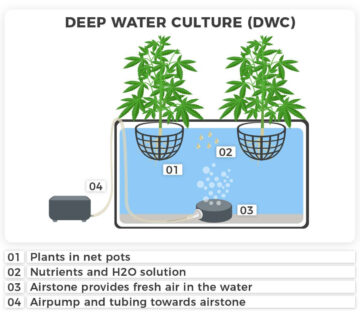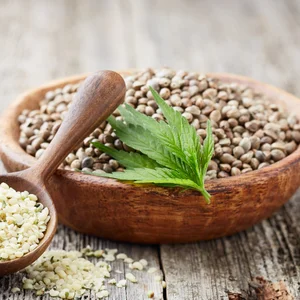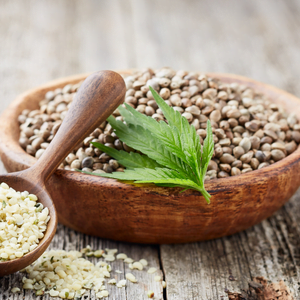Marijuana cultivation is a hobby that keeps on giving, and techniques like cannabis plant training can take your grow to the next level. Once you have a few harvests under your belt with our Harvest Guide and a successful light and nutrient schedule with our Plant Care Guide, you’re ready for the next step. Optimize your output and increase yields by training cannabis plants as you grow them.
Plant training is a cultivation technique that involves manipulating marijuana plants with tie-downs, unique trimming, trellises, and more to increase the number of bud sites and yields. Because cannabis is such a vigorous plant, it will continue to thrive in these conditions. It will also expose more of the plant to light, allowing for more uniform buds in your grow.
What is cannabis plant training?
Few things pique a grower’s interest more than “increased yields,” and training cannabis plants does not disappoint. The great thing is that you don’t need to change the environment or anything in your lights to see drastic improvement. Physically forcing the cannabis plant to grow in a preferred way lets you avoid the natural tendency to end up looking like a Christmas tree with one single massive cola. Cannabis plant training creates multiple smaller bud sites allowing your plants to be more efficient with your resources.
Training cannabis maximizes the time and energy you put into your grow; there are multiple different plant training techniques to do this, including bending, pruning, and more, covered below. Many of the methods can be combined to increase effectiveness. Relying on the resilient nature of the cannabis plant and a good amount of patience, you can have a sea of green in your tents and a harvest of uniform buds at the end of the line. Training plants also has additional benefits, including controlling airflow and humidity and creating an even canopy.
What is the best time to train cannabis plants?
Most cannabis plants can benefit from plant training. It’s generally always recommended, but when to begin and how long to proceed varies based on the chosen technique. The first caveat is that you want to avoid damaging or pruning auto flowers heavily due to their fixed timeline, and the second is that you don’t want to train late in the lifecycle during flower. The luxury of an extended vegetative stage for photoperiods allows for more intense training.
When your plant canopy lacks uniformity, it may be a sign that it’s time to begin cannabis plant training. With indoor lights covering a specific area, you want to ensure the plant fully utilizes that space. Naturally, growing cannabis plants will create a canopy with high points at the top center cola and low points at the bottom, creating cannabis of different structures and quality across the plant. Another sign of a need for training in your cultivation practice is larf or small airy buds on the lower sections of the plant. Eliminate these bud sites to save energy or expose them to more light with cannabis plant training.
Avoid these mistakes when training cannabis plants
In addition to the specifics below, there are a few general guidelines to remember when training cannabis plants. While cannabis will recover from overtraining or trimming, it will take time.
- If you stress the plant too much, you may stunt its growth instead of improving it. A little goes a long way; be thoughtful about your actions here and watch how your plants respond to discover that fine line for your setup.
- Wait until plants grow to the sixth node before starting your training, and don’t start anything late into your plants’ flowering period. Remember to move the plant around slowly and carefully to avoid that sad sound of a snapping branch when training plants and support those improved buds to keep them healthy.
You’ll need cultivation scissors for trimming, soft plant ties for holding branches down, and screens or nets for sea of green methods. Use stakes and trellis systems to support cannabis plants and twine to create cages or nets. You’ll also need a good awareness of your plant timeline and the methods you’re using to avoid stressing your plants out too much. Experience is also valuable here, so start training cannabis plants today if you haven’t already to get a few reps with it.
What is the right training technique for your plants?
Knowing the variables and details of your setup and goals is necessary to answer this question. When picking the proper training technique for cannabis plants, read the quick summaries below. Then explore our range of how-to articles and Grow Bible to understand the options, along with the pros and cons of each technique.
Low-Stress Training (LST)
Low-Stress Training (LST) is exactly as it sounds – a minimally invasive technique for cannabis plant training. By tying down new growth on the plant, you open it up and allow more light to reach the center and lower branches of the plant. This method works well when paired with topping but can work without topping too.
Using ties, twine, or plant tape along with clips or drilled holes around the edge of your pot, you can train your cannabis plant slowly and avoid causing stress. As new growth appears from the main stem and gets long enough to tie down, continue doing so to create a nice, even canopy and high-yielding plant. It may look odd at first, but when you see the results during the flowering stage, you’ll understand.
Read our in-depth guide on how to apply low-stress training to learn all of the ins and outs of this technique.
High-Stress Training (HST)
High-Stress Training (HST) is a heavier-handed cannabis training technique encompassing a few different methods we’ll discuss later in this article. Topping, along with any training methods that damage or break the plant intentionally when bending or cutting, is an example of HST
This technique is often done before the plant enters vegetation to allow enough time for recovery. While these methods may surprise you, again, seeing the results will change your mind and increase your awe for the cannabis plant overall. Abrupt training like HST will deliver energy to lateral branches across the plant instead of focusing it on the top center colas.
To see exactly how to apply this more intense training method, check out our high-stress training guide.
Manifolding
Manifolding is a form of cannabis plant training that falls under HST. At its core, this is a result of sequential topping. Instead of removing the apical meristem once, you repeat this process every few nodes to create an array of branches, each producing a solid flower like a main cola would. Without the apical meristem found at the top of growing plants, their energy is more uniformly diverted across the plant.
To achieve the manifold effect, split the plant in two during topping. Then after a period of growth, split those main branches further in two to create four and then eight sites. When done in the proper environment, you’ll get a picturesque cannabis plant with eight long, even dense colas. While invasive, this technique can produce wonderful results quickly and reduce the chance of rot that could occur in larger buds.
Where some techniques have you constantly making adjustments like LST, manifolding sets the plant up for success early in its lifecycle.
To learn how to do this properly, read our guide that explains how to manifold like a pro.
Lollipopping
Lollipopping is another HST cannabis plant training method. Lollipopping takes that natural Christmas tree look and manicures it down to a lollipop by trimming all growth to a certain point on your cannabis plants. By doing this, you encourage the plant to focus energy on the topmost colas.
When lollipopping, remove any leaves that are not in the light. Anything that would be obscured by buds at the top of the plant is removed. Visualizing a line across your canopy and trimming the growth below that line is helpful. An added benefit is the airflow each plant can get by freeing up the layers below the main canopy.
We show you exactly how to do this correctly in our pro guide to lollipopping.
Sea of Green
Sea of Green (commonly known as SOG) creates an even canopy that cannabis plant training uses to maximize light use. But instead of directly bending, tying down, or altering your plants, this method forces plants to flower early. That said, don’t try this on your autoflowers.
The goal is to flower photoperiod plants young in order to keep a low footprint for each plant. This lets you pack in as many plants as possible under the lights.
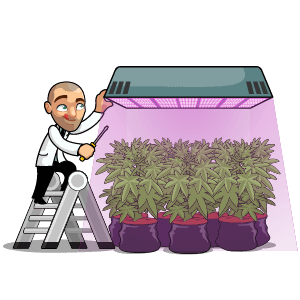

Shop Feminized Seeds
- Female plants for healthy bud
- Quality genetics, high yields
- All popular cultivars
Instead of harvesting 3-5 large plants, you’ll be taking down 15-20 small plants. The result is a dense canopy of smaller plants and a higher yield harvest than larger plants that may take up valuable space under the lights. This approach is good when space is at a premium. It also pairs very well with lollipopping. Before you flip the young plants to flower, lollipop them first to grab your clones for the next round.
Our in-depth guide on how to grow a Sea of Green will help you through the process.
Scrogging
Scrogging is a common technique that creates a “Sea of Green” look to the canopy by securing a screen or net across the canopy at a fixed height. New growth is tied to the screen exposing the whole branch to light. This method optimizes a small space and creates a uniform and plentiful harvest.
The support scrogging provides is also excellent for the plant. As the buds mature and become heavier, the screen can hold them up, preventing unnecessary breaks or bends in late flower. This is one of the easier techniques to get started with in cannabis plant training, and sure to provide improved harvests.
Our scrogging guide shows you how to set up and maintain a proper scrog.
Super Cropping
Super Cropping is an interesting technique that also qualifies as HST. This method involves carefully breaking the stalks of the cannabis plant. You read that right! The trick here is to bend and snap the inner tissues of the plant without damaging the outer skin. Plant tape and/or duct tape are your friend if you make a mistake or two. Do this step early in veg to allow for ample recovery time.
Bending your plant’s stem slowly to a 90-degree angle and tying it that way for a week or two of growth encourages a screen of green kind of lateral growth without using a screen. There’s even a theory that this may increase THC production on the super-cropped branch. The results resemble LST, and the techniques can be combined for a hybrid approach. The key is visualizing a canopy line and uniformly bending things to that level. This method can also be combined with lollipopping to focus energy at the top, but space your training out to avoid stressing the plants out.
Learn how to super crop your plants without doing (too much) damage in our super cropping guide.
Monster Cropping
Monster Cropping continues the trend towards interesting but can provide excellent results and a unique, efficient plant structure. This method harnesses the plant’s response to stress and optimizes the grow. Monster crop by waiting for plants to reach mid-flower stages, then take clones to essentially “re-veg” your plants, putting the clones back through a second veg cycle. The stress of this stage change creates vigorous plants with more bud sites and bushier growth.
While I haven’t tried monster cropping, many claim monster-cropped clones outpace standard clones in production. Remember, this method will not work for autoflowers; once they start flowering, there is no going back. Check out our selection of autoflowering seeds to find the right seeds for your monster grow!


Buy Autoflower Seeds
- For new and experienced growers
- Easy-growing, low maintenance
- All popular cultivars
The stress of this process will kill off a few clones in the beginning, so make sure to take more than you need. You can combine this method with many of the others listed in this article, as Monster Cropping is more of a cloning technique than a trimming or training process but still falls under HST in cultivation.
Learn more about this crazy but effective technique in our monster cropping guide.
Trellising
Trellising is a necessary evil in cannabis cultivation. As your plants get heavier as they mature, they fall over and can eventually snap if left unattended. This is why plants in early flower are trellised with netting or twine and stake solutions to support flower growth through harvest. Trellising can be notoriously difficult to reuse due to sticky harvests, so handling this in a quick and/or disposable way is worth considering.
There are many different approaches to trellising; you can use premade solutions like cages or custom build frames to trellis up sections of your grow. Where the scrogging method adds a screen to the top of the canopy, trellising puts this around the entire plant. Outside of the support given, the trellis provides many tie-down locations for combination with other LST and HST cannabis training techniques.
We’ll show exactly what we mean in our trellising guide.
Schwazzing
Schwazzing is defoliation taken to the extreme. Typical defoliation may remove excess fan leaves or lollipop plants. Schwazzing removes 100% of the fan leaves of a cannabis plant. This process can be done once or twice in the flowering stage of your grow. Complete your first shwazze on day one of flowering, with an optional second around day twenty.
While it may sound like overkill, this method increases airflow and light penetration and directs energy allocation to the maturing flower. Schwazzing can increase yields and is combinable with many of the methods listed in this article to create an even or manifolded canopy while performing LST or HST.
Make sure you read our schwazzing guide before attempting this extreme defoliation method!
How do you train cannabis plants for maximum yield?
So which method is right for you and your grow? Your ideal training program will depend on your goals for the plants and your interest as a cultivator. Don’t feel pressured to combine three or more methods. Start simple, and when in doubt, use LST.
The way I learned and what I currently prefer is topping in veg once, along with some LST, followed by a lollipop in late veg/early flower. I then apply a trellis with an optional semi-schwazze mid-flower. My next batch will be my first attempt at manifolding, which I’ll run along with scrog and monster-cropped clones. The methods here and their various combinations will unlock potential in your grow and optimize the flower quality and quantity.
Are you plant training? Leave a comment below with the methods you’re using or those you plan to try later and don’t forget to grab some fresh genetics from our curated seed collection.
Keep on growing!
- SEO Powered Content & PR Distribution. Get Amplified Today.
- PlatoData.Network Vertical Generative Ai. Empower Yourself. Access Here.
- PlatoAiStream. Web3 Intelligence. Knowledge Amplified. Access Here.
- PlatoESG. Automotive / EVs, Carbon, CleanTech, Energy, Environment, Solar, Waste Management. Access Here.
- BlockOffsets. Modernizing Environmental Offset Ownership. Access Here.
- Source: https://www.ilovegrowingmarijuana.com/growing/cannabis-plant-training/
- :has
- :is
- :not
- :where
- $UP
- 1
- 25
- 300
- a
- About
- Achieve
- across
- actions
- added
- addition
- Additional
- additional benefits
- Adds
- adjustments
- After
- again
- All
- allocation
- allow
- Allowing
- allows
- along
- already
- also
- always
- amount
- an
- and
- Another
- answer
- any
- anything
- Apply
- approach
- approaches
- ARE
- AREA
- around
- Array
- article
- articles
- AS
- At
- attempting
- auto
- avoid
- awareness
- AWE
- back
- based
- BE
- because
- become
- before
- begin
- Beginning
- below
- benefit
- benefits
- BEST
- Bottom
- Branch
- branches
- Break
- Breaking
- breaks
- build
- but
- by
- cages
- CAN
- Can Get
- cannabis
- Canopy
- care
- carefully
- causing
- Center
- certain
- Chance
- change
- check
- chosen
- Christmas
- claim
- clips
- cola
- combination
- combinations
- combine
- combined
- comment
- Common
- commonly
- complete
- conditions
- Cons
- considering
- constantly
- continue
- continues
- Core
- correctly
- could
- covered
- covering
- crazy
- create
- creates
- Creating
- crop
- cultivation
- curated
- Currently
- custom
- cutting
- cycle
- damage
- damaging
- day
- deliver
- details
- different
- difficult
- directly
- discover
- discuss
- do
- does
- doing
- done
- Dont
- doubt
- down
- due
- during
- each
- Early
- easier
- Edge
- effect
- Effective
- effectiveness
- efficient
- eight
- eliminate
- encompassing
- encourage
- encourages
- end
- energy
- enough
- ensure
- Enters
- Entire
- Environment
- essentially
- Even
- eventually
- Every
- exactly
- example
- excellent
- excess
- experience
- experienced
- Explains
- explore
- extreme
- Fall
- Falls
- fan
- feel
- few
- Find
- fine
- First
- fixed
- Flip
- flower
- Focus
- focusing
- followed
- Footprint
- For
- Forces
- form
- found
- four
- fresh
- friend
- from
- fully
- further
- General
- generally
- Genetics
- get
- given
- Giving
- goal
- Goals
- Goes
- going
- good
- grab
- great
- Green
- Grow
- Growing
- Grows
- Growth
- guide
- guidelines
- Handling
- harvest
- Harvesting
- Have
- healthy
- heavily
- height
- help
- helpful
- here
- High
- higher
- his
- hold
- holding
- Holes
- How
- How To
- HTTPS
- Hybrid
- i
- I’LL
- ideal
- if
- improved
- improvement
- improving
- in
- in-depth
- Including
- Increase
- Increases
- Indoor
- instead
- intentionally
- interest
- interesting
- into
- involves
- IT
- ITS
- Keep
- Key
- Kill
- Kind
- known
- large
- larger
- Late
- later
- layers
- LEARN
- learned
- Leave
- left
- Lets
- Level
- lifecycle
- light
- like
- Line
- Listed
- little
- locations
- Long
- Look
- looking
- Low
- lower
- Luxury
- Main
- maintain
- make
- Making
- manipulating
- many
- marijuana
- massive
- mature
- Maximize
- maximizes
- maximum
- May..
- mean
- method
- methods
- mind
- mistake
- mistakes
- more
- more efficient
- move
- much
- multiple
- my
- Natural
- Nature
- necessary
- Need
- net
- Nets
- netting
- New
- next
- nice
- no
- node
- nodes
- number
- obscured
- occur
- of
- off
- often
- on
- once
- ONE
- open
- Optimize
- Optimizes
- Options
- or
- order
- Other
- Others
- our
- out
- output
- outside
- over
- overall
- Pack
- paired
- pairs
- Patience
- penetration
- performing
- period
- Physically
- Picturesque
- plan
- plants
- plato
- Plato Data Intelligence
- PlatoData
- Point
- points
- Popular
- possible
- pot
- potential
- practice
- prefer
- preferred
- Premium
- preventing
- Pro
- process
- produce
- producing
- Production
- Program
- proper
- properly
- PROS
- provide
- provides
- put
- Puts
- Putting
- quality
- quantity
- question
- Quick
- quickly
- range
- reach
- Read
- ready
- recommended
- Recover
- recovery
- reduce
- relying
- remember
- remove
- Removed
- removing
- repeat
- resilient
- Resources
- Respond
- response
- result
- Results
- reuse
- right
- round
- Run
- Said
- Save
- schedule
- Screen
- screens
- SEA
- Second
- sections
- securing
- see
- seeds
- seeing
- selection
- set
- Sets
- setup
- show
- Shows
- sign
- Simple
- single
- Sites
- sixth
- Skin
- Slowly
- small
- smaller
- Snap
- So
- Soft
- solid
- Solutions
- some
- Sound
- Space
- specific
- split
- Stage
- stages
- stake
- standard
- start
- started
- Starting
- Stem
- Step
- sticky
- Still
- stress
- structure
- success
- successful
- such
- Super
- support
- sure
- surprise
- Systems
- Take
- taken
- takes
- taking
- techniques
- than
- that
- THC
- The
- their
- Them
- then
- theory
- There.
- These
- they
- thing
- things
- this
- those
- three
- Thrive
- Through
- TIE
- Tied
- Ties
- time
- timeline
- tissues
- to
- today
- too
- top
- topmost
- towards
- Train
- Training
- tree
- Trend
- tried
- try
- Twice
- two
- typical
- under
- understand
- unique
- unlock
- until
- use
- uses
- using
- utilizes
- Valuable
- variables
- various
- very
- Waiting
- want
- Watch
- Way..
- we
- week
- WELL
- What
- when
- which
- while
- whole
- why
- will
- with
- without
- wonderful
- Work
- works
- worth
- would
- Yield
- yields
- you
- young
- Your
- zephyrnet

